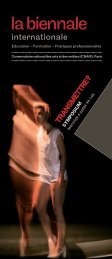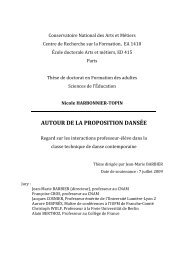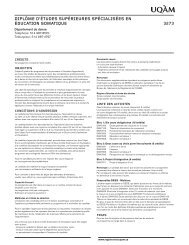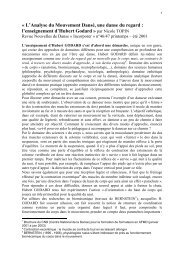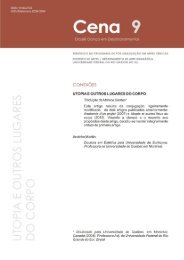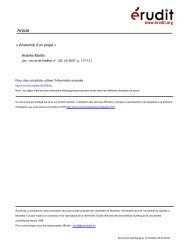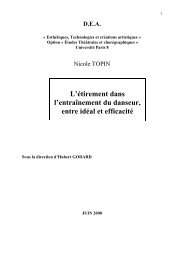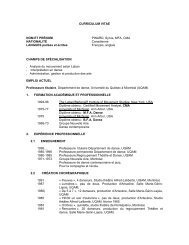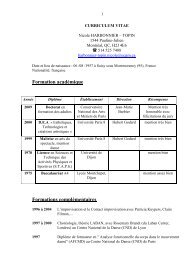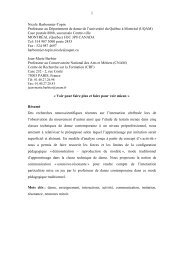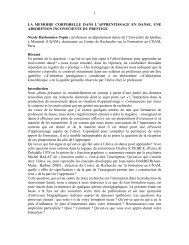Day 2 - Département de danse - UQAM
Day 2 - Département de danse - UQAM
Day 2 - Département de danse - UQAM
You also want an ePaper? Increase the reach of your titles
YUMPU automatically turns print PDFs into web optimized ePapers that Google loves.
d) Theatres of (Ir)reverence: The Ethics of Performing Biography, Religion, War Fine Arts 103<br />
Open Panel Mo<strong>de</strong>rator: Jenn Stephenson (Queen’s University)<br />
“Reflections on Impossible Pursuits: Staging Harry Partch.” Conrad Alexandrowicz (University<br />
of Victoria)<br />
This essay traces the <strong>de</strong>velopment and production of the performance work entitled The Boy Who Went Outsi<strong>de</strong>, which took<br />
as its point of <strong>de</strong>parture the life, work and struggles of the American musical revolutionary and composer Harry Partch (1901-<br />
1973). It is at once a personal reflection, the biography of a stage production, an argument about discursive hegemony, and a<br />
contribution to the ongoing discussion amongst artists and scholars about the problematized texts that fall un<strong>de</strong>r the rubric of<br />
‘auto/biographical theatre.’ In the course of <strong>de</strong>scribing this work I aim to <strong>de</strong>monstrate that this kind of theatre as much<br />
‘autobiography’ as it ‘biography’—or rather, that it is neither, as the theatre cannot sustain meaning in a way that is equivalent<br />
to that of written text.<br />
Why did I choose to tell Partch’s story? Is it because I felt an affinity with his outcast status? Not only a composer, he was<br />
also an innovative theorist, who, in the 1920s and ‘30s, formulated an entirely new system of tuning. He rejected Western<br />
music, in particular its dissociation from other art forms, and so also became a musical dramatist who wrote his own texts and<br />
created music-dance-theatre works. He may have been the first serious interdisciplinary artist of the 20th Century in the West.<br />
Partch’s story offers truths about how mo<strong>de</strong>s of cultural production are established and perpetuated, and how rival<br />
discourses are ghettoized or even erased. This is a reflection on an impossible work based on the life and work of an<br />
impossible artist, who was driven by an impossible mission.<br />
“Religious and Secular Bodies and the Extreme: Raffaello Sanzio and the Post-Secular.” Megan<br />
Macdonald (In<strong>de</strong>pen<strong>de</strong>nt Scholar / Visiting Research Fellow at the University of Victoria)<br />
Reviews of Raffaello Sanzio’s On the concept of the face: Regarding the son of God focus on the switch “from mundane<br />
medical realism [to] apocalyptic iconoclasm” (Michael Billington). This piece caused upheaval in Paris, and protests in<br />
Montreal because of its treatment of the image of Christ. The piece started with a son looking after his incontinent father in a<br />
white living space that ends covered in ‘excrement.’ The second part involved children throwing grena<strong>de</strong>s at a huge image of<br />
Christ on the back wall, and in the third part the image was ripped apart and covered in more ‘filth.’ The piece was well<br />
received throughout most of Europe but even then the critical attitu<strong>de</strong> at work in the responses point to a notion of<br />
iconoclasm—that the creators of the piece must necessarily be breaking down the untruth of religion to make way for<br />
philosophical truth.<br />
I want to question the assumptions about materiality and temporality in relation to the use of religious symbols in theatre<br />
ma<strong>de</strong> by reviewers and aca<strong>de</strong>mics. Through an analysis of the piece, reviews and commentary, Iwill argue that the<br />
performances of these bodies and the use of an image of the historical body of Christ are not bound by an assumed postsecular<br />
paradigm. Drawing on the work being done in the field of post-secular studies, I will argue that this piece performs a<br />
nuanced contemplation on religion that bypasses social-scientific categories framed by Western Protestant theological<br />
concepts. By examining the bodies on stage in light of current research we will see other patterns emerging from this piece<br />
that trouble long held un<strong>de</strong>rstandings of how the body must function when put in relation to religious images and symbols, and<br />
prove more extreme than the ‘fecal’ matter that covers the stage.<br />
“‘Foreign Exchange’: The Transnational Mobility of Colleen Wagner’s The Monument” Sarah<br />
Waisvisz (Carleton University)<br />
Colleen Wagner’s 1993 Governor General’s Award-winning play The Monument is set at the end of a civil war in an unnamed<br />
place. Inspired by “rumours out of Yugoslavia” (Wagner quoted in Capraru, 2009), the play stages the confrontation between a<br />
soldier accused of mass rape and mass mur<strong>de</strong>r, and the mother of one of his victims. The play’s vague setting has allowed it<br />
to be adapted to different contexts including the Sudan, the DRC, and Rwanda. In<strong>de</strong>ed the play’s resonance with other<br />
contexts has led to criticism that the script universalizes and flattens the unique issues of particular contexts (Moberley Luger,<br />
2009). The most striking example of its adaptability is the production staged by Rwandan theatre company ISÔKO and<br />
directed by Jennifer Capraru, a Canadian <strong>de</strong>scendant of European Holocaust-survivors. Translated into Kinyarwanda, and<br />
staged by Rwandan artists for post-genoci<strong>de</strong> Rwandan spectators, and then later “returning home” to Canada in a subtitled<br />
touring production, Capraru’s artistic project is fraught with controversy including charges of cultural appropriation and<br />
irresponsibility (Lisa N<strong>de</strong>jura, 2009).<br />
Yet how different is Capraru’s mission from Wagner’s? In other words, why do so many Canadian artists feel compelled to<br />
intervene in international cases of human rights violations? Is this type of intervention from artists, who are often not-directly<br />
related to the event or context, appropriating and racist? Or is the intervention “legitimate” if, like Capraru, the artist feels a<br />
kinship to the event based on a similar event in their own family and country of origin? Instead, perhaps this risk of<br />
appropriation can be seen entirely differently as an effort to invoke and encourage a transnational strategy of witnessing that<br />
could mobilize a more active, ethically responsible theatre public. In this paper I argue that Wagner’s The Monument and<br />
Capraru’s production with ISÔKO are both suggestive of a critical labour of repair, rectification, and remediation that needs to<br />
be part of the work of transitional justice and redress in conflict zones both on foreign shores as well as here, “at home.”<br />
31



